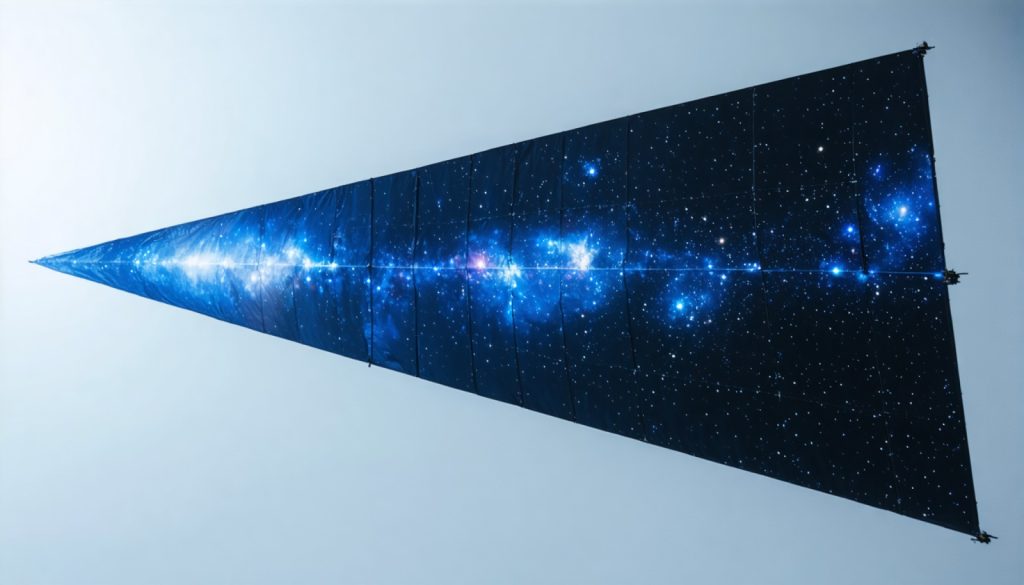
- Voyager 1, launched in 1977, symbolizes human ambition but hasn’t reached beyond the solar system, unlike future goals.
- An innovative lightsail, a nanometer-thin sheet reflecting sunlight, promises to propel spacecraft beyond current limits.
- Developed by researchers at Brown University and Delft University of Technology, it maximizes light reflection and minimizes weight.
- Inspired by the Starshot Breakthrough Initiative, the sail aims for interstellar travel using photons from Earth-based lasers.
- Core material silicon nitride provides strength and lightness; machine learning optimizes hole distribution for light interaction.
- This breakthrough not only advances space travel but also revolutionizes nanoscale engineering and problem-solving.
- Human innovation, fueled by AI and visionary science, continues to push the boundaries of exploration.
Across the vast, inky expanse of our universe, Voyager 1 drifts silently, a testament to human ingenuity. Yet, even this iconic spacecraft, launched in 1977, hasn’t ventured far enough to graze the secrets of our nearest stellar neighbor, Alpha Centauri. Now, a groundbreaking development might hold the key to propelling our dreams beyond the confines of our solar system: the lightsail.
Imagine a gossamer-thin sheet, floating quietly through space, pushed not by the roar of engines but by the gentle caress of sunlight. This is the vision scientists from Brown University and Delft University of Technology are bringing to life. Their collaboration has yielded an extraordinary prototype – a lightsail forged from a material mere nanometers thick and interwoven with billions of minute holes. These precision-engineered holes imbue the sail with an almost magical capability: maximizing light reflection while minimizing weight.
Miguel Bessa and Richard Norte lead this pioneering effort, driven by an insatiable curiosity and aided by the power of machine learning. Their creation boasts the largest aspect ratio ever recorded for a lightsail, proving that even the most audacious engineering dreams are within reach. By weaving together theory and experimentation, their teams have paved a cost-effective path to the stars, a journey once unfathomably distant.
Their lightsail draws inspiration from the Starshot Breakthrough Initiative – a visionary endeavor that dreams of tiny spacecraft hurtling to Alpha Centauri at breakneck speeds. These ambitious projects envision sails devoid of propulsion needs, propelled instead by photons from Earth-based lasers. The Brown and TU Delft prototype aligns beautifully with this strategy, offering a scalable solution that might one day whisk us across interstellar voids.
Central to this breakthrough is silicon nitride, selected for its exceptional blend of lightness and strength. Through sophisticated AI algorithms, researchers determined the optimal distribution of nanoscale holes, optimizing the sail’s interaction with light. This intricate dance of design and technology ensures the sail capitalizes on every speck of scattered light, enabling it to glide through space faster and further than ever before.
But this journey to the edges of possibility also unlocks new avenues in nanoscale engineering. The use of machine learning to navigate complex design challenges isn’t confined to space exploration. It heralds a novel approach, offering a toolkit that could revolutionize engineering fields long thought static and unsolvable.
The fruits of this research extend beyond the stars; they symbolize an evolution in how we tackle grand challenges. By marrying cutting-edge technology with visionary science, this lightsail does more than inch us closer to the stars—it symbolizes our relentless pursuit of the unknown.
As we stand on the precipice of interstellar exploration, one wafer-thin sheet at a time, the message is clear: the universe is vast, but human innovation may one day light the way to its farthest reaches.
How Lightsails Could Revolutionize Space Exploration and Beyond
Unveiling the Potential of Lightsails in Space Travel
The Voyager 1 spacecraft, launched in 1977, remains a cornerstone of human achievement in space exploration. However, the vast expanse of the universe still beckons with mysteries yet unsolved. Enter the lightsail, a revolutionary technology offering the promise of reaching interstellar distances that were once deemed unattainable. This promising advancement, spearheaded by scientists from Brown University and Delft University of Technology, opens new chapters in our quest to reach nearby stars like Alpha Centauri.
How Do Lightsails Work?
Lightsails operate on a simple yet profound principle: harnessing the pressure exerted by photons, or light particles, from the sun or powerful lasers. Unlike traditional propulsion, which relies on burning fuel, a lightsail utilizes the momentum of reflecting photons to accelerate through space. This offers a myriad of benefits, including the elimination of fuel mass, potentially leading to smaller, more efficient spacecraft.
Real-World Use Cases and Future Prospects
In addition to space exploration, the lightness and efficiency of lightsails hold promise for satellite deployment and maintenance. They provide a sustainable alternative to conventional propulsion systems, reducing dependence on finite fuel sources. As the technology matures, we may witness its application in space debris management, satellite repositioning, and even solar energy harvesting in space.
Key Materials and Techniques
Central to the Brown and TU Delft team’s success is the innovative use of silicon nitride, prized for its favorable strength-to-weight ratio. By integrating advanced AI algorithms, researchers refined the distribution of nanoscale holes, optimizing the sail’s reflectivity. This breakthrough not only advances the field of photonics but also sets a precedent for utilizing machine learning in complex engineering challenges.
Challenges and Limitations
Despite the promise lightsails hold, several challenges remain. The primary hurdle is engineering a sufficiently powerful and precise laser system on Earth that can propel these sails over vast distances. Additionally, the durability of the lightsail material under prolonged exposure to cosmic radiation and micrometeoroids needs thorough testing.
Insights and Market Forecast
The development and deployment of lightsails are expected to influence the satellite and propulsion systems market significantly. According to market analysts, the trend towards lightweight and fuel-efficient space technologies is anticipated to grow exponentially as the commercial space sector expands.
Security and Sustainability
Lightsail technology exemplifies sustainability in space travel by eliminating fuel requirements. This not only reduces payload mass but also aligns with efforts to minimize space debris, a growing concern for the industry. Safety protocols for laser systems involved in lightsail propulsion will be critical to their operational success.
Actionable Recommendations
– For Enthusiasts: Stay informed about research breakthroughs in lightsail technology and support initiatives that aim to reduce costs and increase the accessibility of space exploration.
– For Industry Professionals: Consider investing in or partnering with companies and research teams that are at the forefront of developing sustainable and efficient space propulsion systems.
– For Educators: Use the development of lightsails as a tool to inspire students in fields of physics, engineering, and computer science, highlighting real-world applications of these academic disciplines.
To follow the latest in space exploration technologies and venture solutions, visit NASA or ESA for authoritative information and updates.
In conclusion, the revolution of lightsails in space travel embodies the zenith of human ingenuity, offering pathways not only to distant stars but also to more responsible and innovative ways of exploring the vast cosmos. As research continues to evolve, embracing this technology could very well be our key to unlocking the next era of interstellar exploration.



